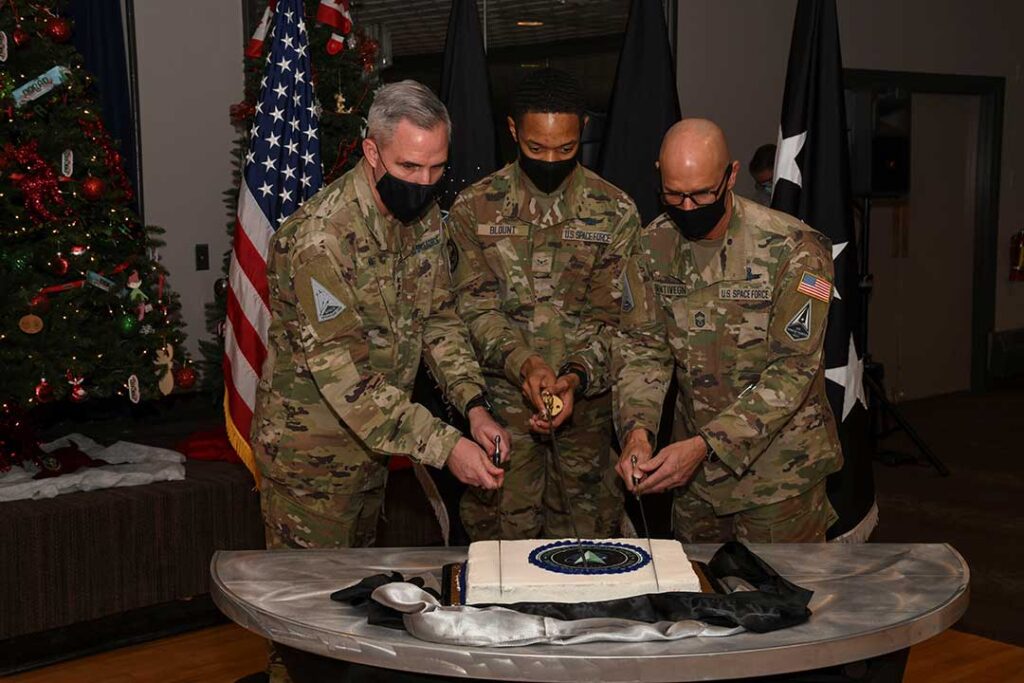THE WATCH STAFF
The U.S. Space Force, which marked its second birthday December 20, 2021, has unveiled a website with the dual purpose of recruiting the next generation of Guardians and explaining its military mission.
The Space Force is an independent service under the Department of the Air Force that was signed into law in 2019. Since then, its ranks have grown to more than 6,500 uniformed Guardians and about an equal number of civilian employees, according to a December 18 SpaceNews story.
(Pictured: Lt. Gen. Stephen Whiting, Space Operations Command commander; U.S. Space Force Spc. 3 Justin Blount, Missile Warning Center technician; and Chief Master Sgt. John Bentivegna, Space Operations Command chief; cut the cake December 20 during the U.S. Space Force’s birthday celebration at Peterson Space Force Base, Colorado.)
The website SpaceForce.com also includes the service’s recruiting commercial, “Origins,” which emphasizes the importance of protecting U.S. military and commercial satellites and capabilities.
“I think probably 100% of recruits will have visited the SpaceForce.com website at some point,” Barry Dickey, Air Force Recruiting Service director of strategic marketing, told Air Force Magazine on December 21.
“Unless you walk into a recruiter’s office and fill out an application, this is where we get the majority of them.”
Lt. Gen. Nina Armagno, director of the Space Force staff, said that when the service was created, the public did not understand why the military branch was necessary.
“I think at first it was a little tough to realize the American people thought we were a joke … thank you Netflix,” Armagno said, referencing the TV series “Space Force” at a Washington Space Business Roundtable event December 15, according to SpaceNews. “We decided we had to keep educating and keep talking about Space Force, what it provides, where we’re going in the future and why it’s so important.”
Despite its brief history, lawmakers have begun to criticize the Space Force for the slow pace of its acquisition programs amid concerns that it is being hindered by bureaucracy as it seeks to modernize satellites and capabilities, according to a December 15 SpaceNews story. It is also being faulted for not integrating advanced technologies from the commercial space sector.
“I think Space Force — and Space Command [USSPACECOM], don’t forget there are two new entities here — have made great progress. But they still have a long way to go,” U.S. Rep. Jim Cooper, chairman of the House Armed Service’s Strategic Forces Subcommittee, told Breaking Defense in a December 13 interview. USSPACECOM is the unified combatant command for all military space operations.
Undersecretary of the Air Force Gina Ortiz Jones said the Space Force’s small size — it is about one-tenth the size of the next smallest branch, the U.S. Marine Corps — can be an advantage.
“The Space Forces is new, and the bureaucracy isn’t fully baked into every process, luckily, and we’ll work hard to make sure it doesn’t get baked in,” she said at the U.S. Chamber of Commerce’s Space Summit on December 16.
The day before Ortiz Jones’ remarks, the White House announced that President Joe Biden had nominated Frank Calvelli to be assistant secretary of the Air Force for space acquisition.
Calvelli worked for 30 years at the National Reconnaissance Office. From 2012 to 2020, he was the principal deputy director, overseeing satellite and ground system acquisitions, systems engineering and satellite operations, according to the White House. If confirmed by the Senate, Calvelli will become the first senior procurement executive in charge of military space programs, a post mandated by Congress in the 2020 National Defense Authorization Act, according to SpaceNews.
That position is seen as especially critical in the wake of recent space activity — ranging from hypersonic missile tests to anti-satellite weapons — by Russia and the People’s Republic of China.
Armagno suggested that reports of those operations by potential U.S. adversaries reaffirm the crucial role of space in national security.
“There’s a lot of strategic competition in space,” she said, “and I think Americans are seeing it.”
IMAGE CREDIT: AIRMAN 1ST CLASS AARON EDWARDS/U.S. SPACE FORCE

